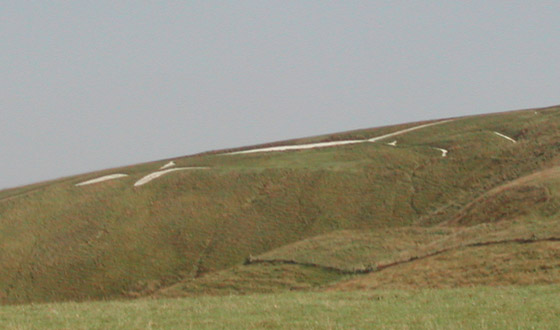Introduction
In Wiltshire, Near Stonehenge, the ground is made of white chalk rather than the typical brown dirt. This is evident along hiking trails, where the treaded pathway is white. This means that you can create large lines and pattern them in recognizable figures. It was not rocket science to figure out that chalked figures were visible for miles, and three thousand years ago, the outlines of a horse were set in a hillside in Uffington. Thousands of years later, people decided to continue a tradition of creating white horses on hillsides even as recent as 2000. The difference between the ancient horse and the modern ones is how they were created. The ancient horse's lines were dug as a trench and then chalk was used to fill in the trench. The modern ones are worn from the surface of the land.
The White Horse of Uffington

This was the horse I had been waiting to see. I bought a pamphlet at the Stonehenge gift shop that had a small map on the horses and some information as well. The drive was a bit long and we were never sure if we had gone too far, but we were glad me made the effort.
I must confess that it was a bit of a disappointment that there is no excellent vantage point to stand at to see the whole horse, though you can walk up to the horse to see how it was made close up.
The hike to the horse is a steep uphill climb, and this is after we drove up a winding road to get to the parking lot. The hike is rather popular with people of all ages, and many do the walk just to enjoy the fabulous vista from the top.
References to this horse have appeared in documents dating back 900 years. Archeologists have determined that the horse carved on the hill is about 3000 years old. The style of the horse is similar to ones found on early Iron Age coins.
Uffington Castle Hill Fort

The remains of a 2700 year old fort covers 3 acres on the top of the hill, along with some burial mounds. There are markers on the top explaining the history of it.
Dragon Hill
From the top of the hill where the fort once stood, you can see a mound below that has no grass on top - only chalk. Grass will not grow there because St. George slew dragons there and their blood poisoned the surrounding earth. So there you go.

We purchased a small pamphlet on the horses that included a map. The pamphlet was compiled and published by J & M Young of 54 George Lane, Marlborough, Wiltshire SN8 4BY.


